Determination of the features of the course of pregnancy and childbirth, the condition of the fetus and newborn in pregnant women after the application of assisted reproductive technologies (data from a retrospective analysis)
DOI:
https://doi.org/10.15574/HW.2023.168.4Keywords:
pregnancy, assisted reproductive technologies, fetal condition, pregnancy complications, newborn’s condition, womenAbstract
The rapid growth in the number of infertile couples leads to the development of assisted reproductive technologies (ART). Among the most common forms of infertility are tubo-peritoneal, endocrine, and caused by the male factor, and prevention of pregnancy complications caused by ART treatment cycles becomes one of the main tasks of practicing clinicians.
Purpose - to determine the features of the course of pregnancy and childbirth; to assess the condition of the fetus and newborn in pregnant women after the application of ART to improve the perinatal outcomes of pregnancy and childbirth.
Materials and methods. A retrospective clinical and statistical analysis of 334 histories of pregnancy and childbirth of women, as well as medical records of newborns from women, was conducted over the past five years, which formed the ART group - 221 history of pregnancy and childbirth, and the group of spontaneous pregnancy - 113 history of pregnancy and childbirth.
Results. The structure of the subjects was statistically significant dominated by pregnant women over the age of 35 years and pregnant women in late reproductive age. The main characteristics of women after the ART application were a statistically significant predominance of somatic and gynecological pathology. The structure of pregnancy complications in women after ART application was dominated by threatening late spontaneous miscarriages, isthmic-cervical insufficiency and vaginitis, and in the structure of labor complications - anomalies of labor activity and premature rupture of fetal membranes. Among newborns from women in the ART group, perinatal mortality was 18.0%.
Conclusions. The revealed features of somatic and gynecological anamnesis, as well as aspects of the course of pregnancy and childbirth and the condition of newborns in women after ART application are the basis for an in-depth examination of this category of pregnant women in order to improve approaches to predicting, diagnosing and optimizing preventive measures, as well as to improve the perinatal consequences of pregnancy and childbirth.
The research was carried out in accordance with the principles of the Helsinki Declaration. The study protocol was approved by the Local Ethics Committee of the participating institution.
No conflict of interests was declared by the authors.
References
Alain S. (2013). Screening for CMV: fertility, prenatally, postnatally. Abstracts of the 29th Annual Meeting of the European Society of Human Reproductionuction and Embriology. 7-10 July 2013, London, United Kingdom. Human Reproduction. 28: 58.
Avramenko N, Semenenko I, Sjeryh K. (2019). Features of postgraduate education of family doctors on family planning and infertile marriage. Young scientist. 10 (74): 402-405. https://doi.org/10.32839/2304-5809/2019-10-74-86
Beniuk VO, Vygivska LM, Maidannyk IV, Oleshko VF. (2019). Psycho-emotional state of women with spontaneous pregnancy and after use of assisted reproductive technologies. Health of Woman. 10 (146): 10-15. https://doi.org/10.15574/HW.2019.146.10
Deshmukh H, Way SS. (2019). Immunological Basis for Recurrent Fetal Loss and Pregnancy Complications. Annu Rev Pathol. 14: 185-210. https://doi.org/10.1146/annurev-pathmechdis-012418-012743; PMid:30183507 PMCid:PMC6566855
Ferraretti A, Goossens V, de Mouzon J et al. (2013). Assisted reproductive technology in Europe, 2010: results generated from European registers by ESHRE. Human Reproduction. 28: 38-39.
Maslo DN. (2016). Optimization of tactics of conducting pregnancy and labor after auxiliary reproductive technologies. Health of woman. 5 (111): 160-164. https://doi.org/10.15574/HW.2016.111.160
Montagnoli C, Zanconato G, Cinelli G et al. (2020). Maternal mental health and reproductive outcomes: a scoping review of the current literature. Arch Gynecol Obstet. 302 (4): 801-819. https://doi.org/10.1007/s00404-020-05685-1; PMid:32671543
Sur SD, Campbell BK, Raine-Fenning NJ. (2013). How does IVF and the number of embryos transferred affect first trmester growth? Human Reproduction. 28: 4-5.
Vygivksa LM, Maidannyk IV, Usevych IA, Oleshko VF, Manzhula LV. (2020). The condition of utero-placental hemodynamics in pregnant women as a result of the assisted reproductive technologies application. Scientific Digest of Association of Obstetricians and Gynecologists of Ukraine. 2 (46): 20-52. https://doi.org/10.35278/2664-0767.2(46).2020.219467
Downloads
Published
Issue
Section
License
Copyright (c) 2023 Ukrainian Journal Health of Woman

This work is licensed under a Creative Commons Attribution-NonCommercial 4.0 International License.
The policy of the Journal UKRAINIAN JOURNAL «HEALTH OF WOMAN» is compatible with the vast majority of funders' of open access and self-archiving policies. The journal provides immediate open access route being convinced that everyone – not only scientists - can benefit from research results, and publishes articles exclusively under open access distribution, with a Creative Commons Attribution-Noncommercial 4.0 international license (СС BY-NC).
Authors transfer the copyright to the Journal UKRAINIAN JOURNAL «HEALTH OF WOMAN» when the manuscript is accepted for publication. Authors declare that this manuscript has not been published nor is under simultaneous consideration for publication elsewhere. After publication, the articles become freely available on-line to the public.
Readers have the right to use, distribute, and reproduce articles in any medium, provided the articles and the journal are properly cited.
The use of published materials for commercial purposes is strongly prohibited.

